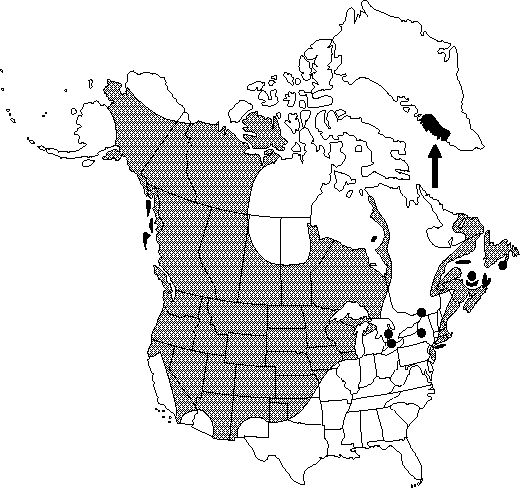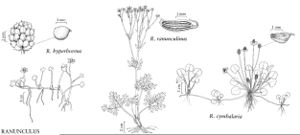FNA>Volume Importer |
FNA>Volume Importer |
| Line 33: |
Line 33: |
| | }}<!-- | | }}<!-- |
| | | | |
| − | --><span class="statement" id="st-d0_s0" data-properties="stem growth form;flowering-stem orientation;flowering-stem orientation;stolon growth form or orientation;stolon architecture;stolon pubescence;stolon pubescence;stolon architecture"><b>Stems </b>dimorphic, flowering-stems erect or ascending, stolons prostrate, rooting nodally, glabrous or sparsely hirsute, not bulbous-based.</span> <span class="statement" id="st-d0_s1" data-properties="root architecture;root presence"><b>Tuberous </b>roots absent.</span> <span class="statement" id="st-d0_s2" data-properties="basal leaf architecture;basal leaf architecture or shape;blade shape;blade shape;blade shape;blade shape;blade length;blade width;base shape;base shape;base shape;margin shape;margin shape;apex shape"><b>Basal </b>leaves simple and undivided, blades oblong to cordate or circular, 0.7-3.8 × 0.8-3.2 cm, base rounded to cordate, margins crenate or crenate-serrate, apex rounded.</span> <span class="statement" id="st-d0_s3" data-properties="receptacle pubescence;receptacle pubescence"><b>Flowers:</b> receptacle hispid or glabrous;</span> <span class="statement" id="st-d0_s4" data-properties="sepal orientation;sepal length;sepal width;sepal pubescence">sepals spreading, 2.5-6 × 1.5-3 mm, glabrous;</span> <span class="statement" id="st-d0_s5" data-properties="petal quantity;petal coloration;petal length;petal width">petals 5, yellow, 2-7 × 1-3 mm.</span> <span class="statement" id="st-d0_s6" data-properties="head shape;head shape;head length;head atypical width;head width"><b>Heads </b>of achenes long-ovoid or cylindric, 6-12 × 4-5 (-9) mm;</span> <span class="statement" id="st-d0_s7" data-properties="achene atypical length;achene length;achene width;achene pubescence">achenes 1-1.4 (-2.2) × 0.8-1.2 mm, glabrous;</span> <span class="statement" id="st-d0_s8" data-properties="beak duration;beak shape;beak course;beak some measurement;2n chromosome quantity">beak persistent, conic, straight, 0.1-0.2 mm. <b>2n</b> = 16.</span><!-- | + | --><span class="statement" id="st-undefined" data-properties=""><b>Stems </b>dimorphic, flowering stems erect or ascending, stolons prostrate, rooting nodally, glabrous or sparsely hirsute, not bulbous-based. <b>Tuberous</b> roots absent. <b>Basal</b> leaves simple and undivided, blades oblong to cordate or circular, 0.7-3.8 × 0.8-3.2 cm, base rounded to cordate, margins crenate or crenate-serrate, apex rounded. <b>Flowers</b>: receptacle hispid or glabrous; sepals spreading, 2.5-6 × 1.5-3 mm, glabrous; petals 5, yellow, 2-7 × 1-3 mm. <b>Heads</b> of achenes long-ovoid or cylindric, 6-12 × 4-5(-9) mm; achenes 1-1.4(-2.2) × 0.8-1.2 mm, glabrous; beak persistent, conic, straight, 0.1-0.2 mm. <b>2n</b> = 16.</span><!-- |
| | | | |
| | -->{{Treatment/Body | | -->{{Treatment/Body |
| Line 60: |
Line 60: |
| | |publication year=1814 | | |publication year=1814 |
| | |special status=Selected by author to be illustrated;Weedy | | |special status=Selected by author to be illustrated;Weedy |
| − | |source xml=https://jpend@bitbucket.org/aafc-mbb/fna-fine-grained-xml.git/src/287ef3db526bd807d435a3c7423ef2df1e951227/V3/V3_786.xml | + | |source xml=https://jpend@bitbucket.org/aafc-mbb/fna-data-curation.git/src/9216fc802291cd3df363fd52122300479582ede7/coarse_grained_fna_xml/V3/V3_786.xml |
| | |genus=Ranunculus | | |genus=Ranunculus |
| | |subgenus=Ranunculus subg. Cyrtorhyncha | | |subgenus=Ranunculus subg. Cyrtorhyncha |
| | |section=Ranunculus sect. Halodes | | |section=Ranunculus sect. Halodes |
| | |species=Ranunculus cymbalaria | | |species=Ranunculus cymbalaria |
| − | |2n chromosome quantity=16
| |
| − | |achene atypical length=1.4mm;2.2mm
| |
| − | |achene length=1mm;1.4mm
| |
| − | |achene pubescence=glabrous
| |
| − | |achene width=0.8mm;1.2mm
| |
| − | |apex shape=rounded
| |
| − | |basal leaf architecture=simple
| |
| − | |basal leaf architecture or shape=undivided
| |
| − | |base shape=rounded;cordate
| |
| − | |beak course=straight
| |
| − | |beak duration=persistent
| |
| − | |beak shape=conic
| |
| − | |beak some measurement=0.1mm;0.2mm
| |
| − | |blade length=0.7cm;3.8cm
| |
| − | |blade shape=oblong;cordate or circular
| |
| − | |blade width=0.8cm;3.2cm
| |
| − | |flowering-stem orientation=ascending;erect
| |
| − | |head atypical width=5mm;9mm
| |
| − | |head length=6mm;12mm
| |
| − | |head shape=cylindric;long-ovoid
| |
| − | |head width=4mm;5mm
| |
| − | |margin shape=crenate-serrate;crenate
| |
| − | |petal coloration=yellow
| |
| − | |petal length=2mm;7mm
| |
| − | |petal quantity=5
| |
| − | |petal width=1mm;3mm
| |
| − | |receptacle pubescence=glabrous;hispid
| |
| − | |root architecture=tuberous
| |
| − | |root presence=absent
| |
| − | |sepal length=2.5mm;6mm
| |
| − | |sepal orientation=spreading
| |
| − | |sepal pubescence=glabrous
| |
| − | |sepal width=1.5mm;3mm
| |
| − | |stem growth form=dimorphic
| |
| − | |stolon architecture=not bulbous-based;rooting
| |
| − | |stolon growth form or orientation=prostrate
| |
| − | |stolon pubescence=hirsute;glabrous
| |
| | }}<!-- | | }}<!-- |
| | | | |
| | -->[[Category:Treatment]][[Category:Ranunculus sect. Halodes]] | | -->[[Category:Treatment]][[Category:Ranunculus sect. Halodes]] |
Stems dimorphic, flowering stems erect or ascending, stolons prostrate, rooting nodally, glabrous or sparsely hirsute, not bulbous-based. Tuberous roots absent. Basal leaves simple and undivided, blades oblong to cordate or circular, 0.7-3.8 × 0.8-3.2 cm, base rounded to cordate, margins crenate or crenate-serrate, apex rounded. Flowers: receptacle hispid or glabrous; sepals spreading, 2.5-6 × 1.5-3 mm, glabrous; petals 5, yellow, 2-7 × 1-3 mm. Heads of achenes long-ovoid or cylindric, 6-12 × 4-5(-9) mm; achenes 1-1.4(-2.2) × 0.8-1.2 mm, glabrous; beak persistent, conic, straight, 0.1-0.2 mm. 2n = 16.
Phenology: Flowering late spring–summer (May–Sep).
Distribution
Bogs, marshes, ditches, stream banks, often saline
Discussion
Various Navaho groups used Ranunculus cymbalaria as a venereal aid, an emetic, and a ceremonial medicine. The Kawaiisu used it as a dermatological aid (D. E. Moerman 1986).
Selected References
None.

